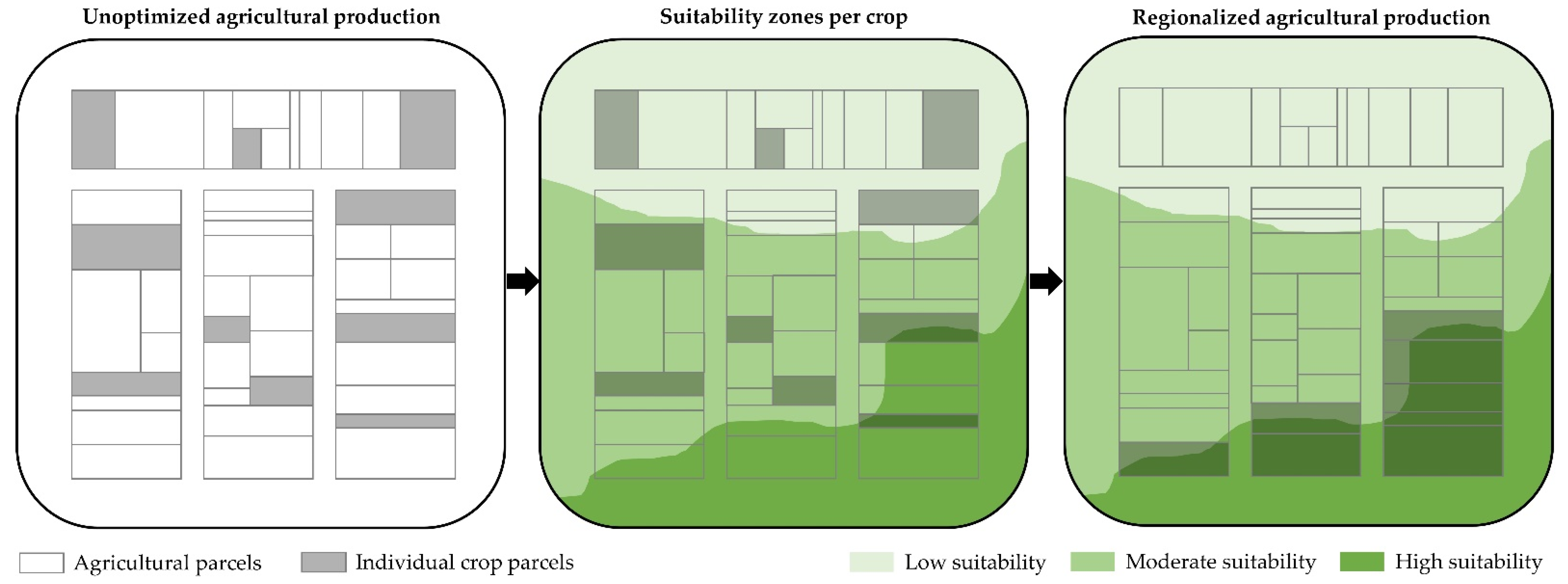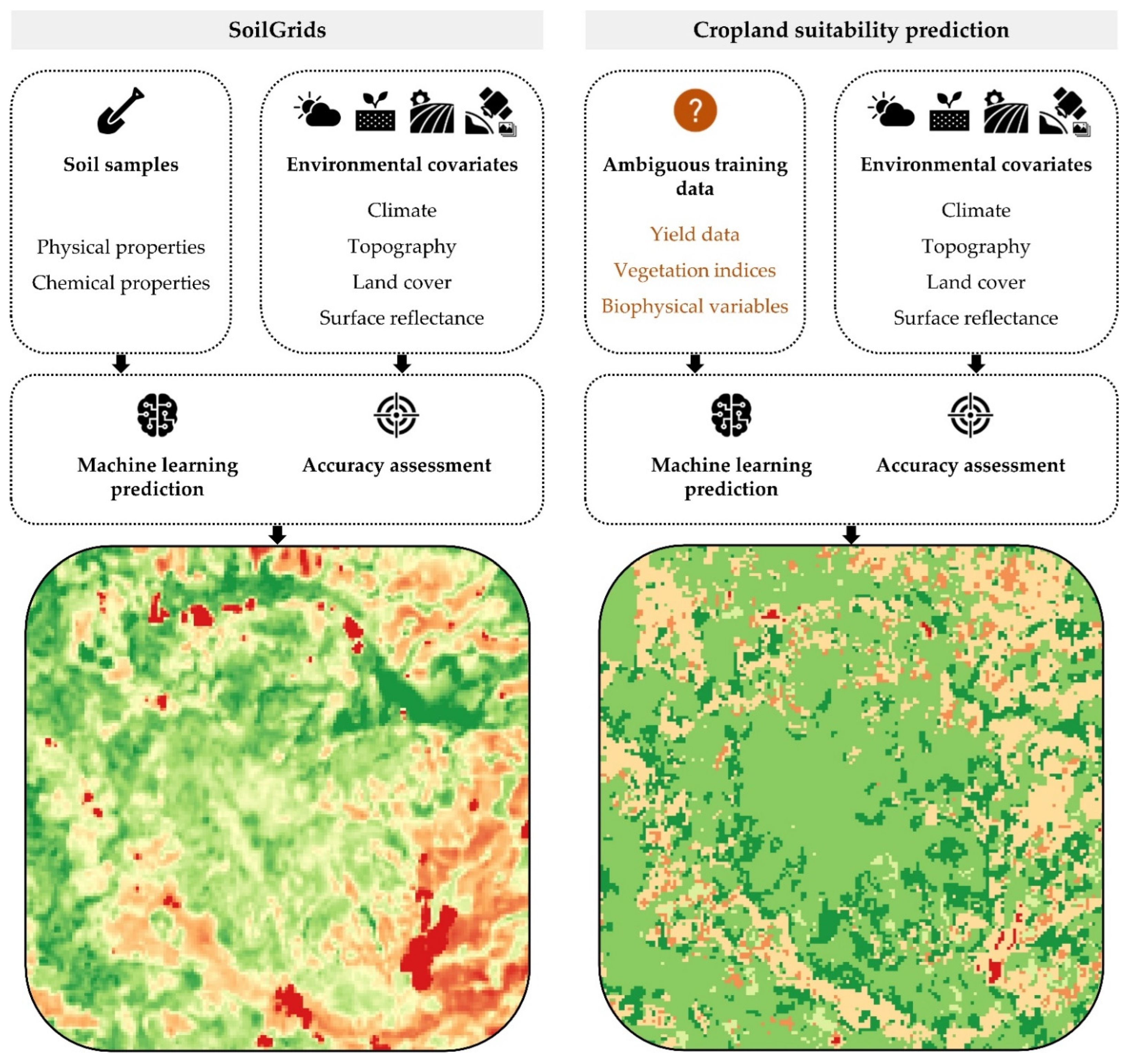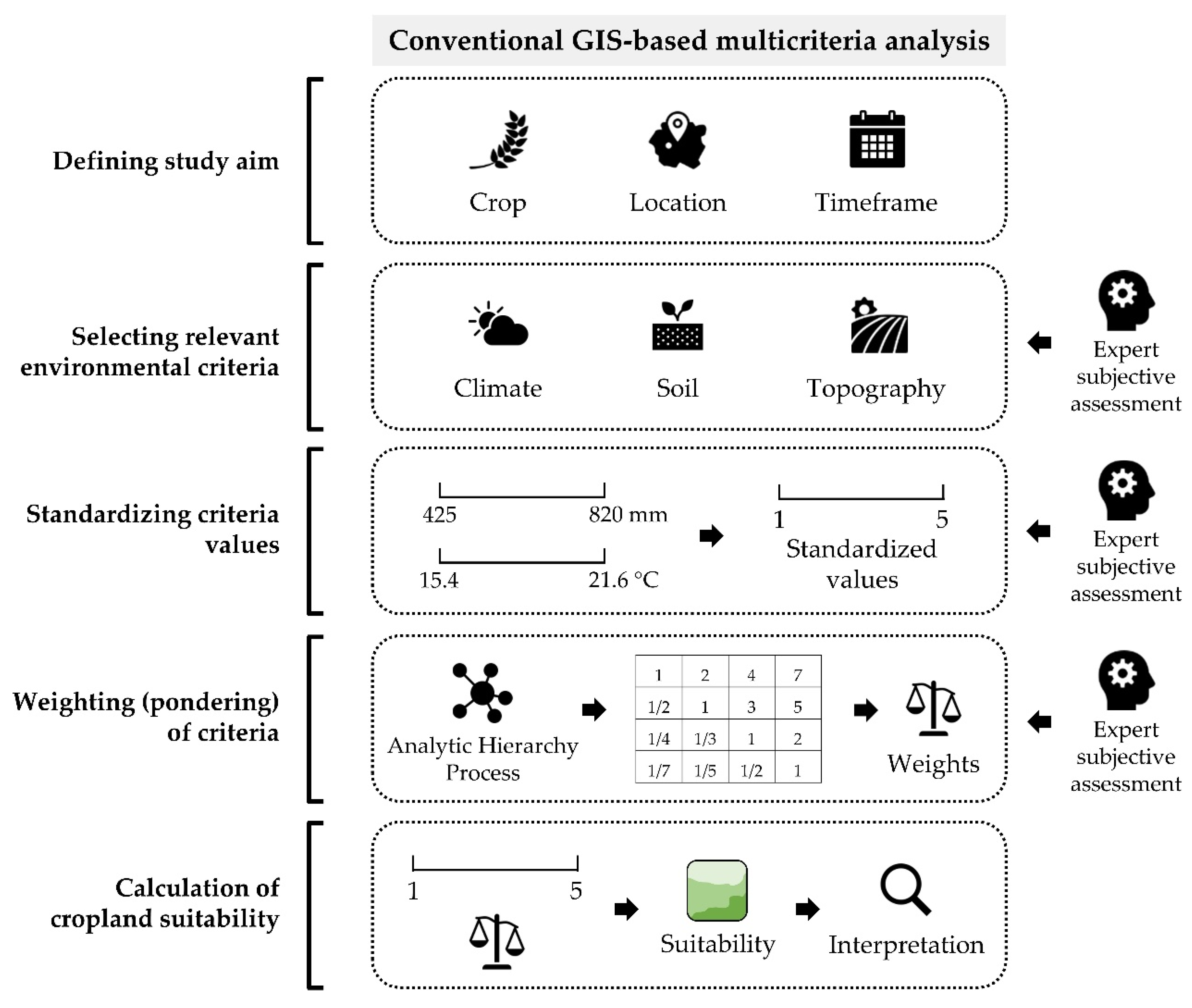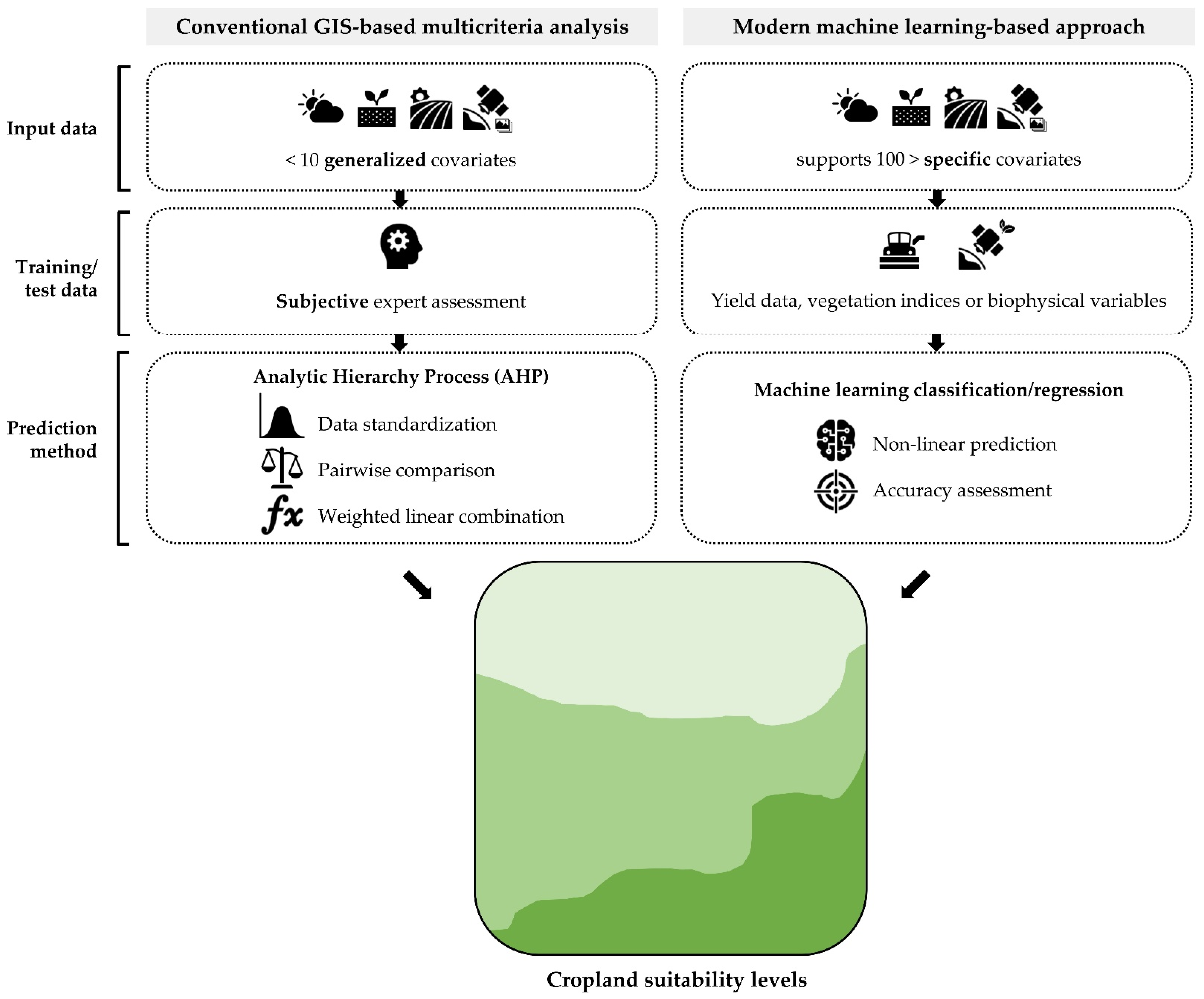The increasing global demand for food has forced farmers to produce higher crop yields in order to keep up with population growth, while maintaining sustainable production for the environment. The conventional method for calculating cropland suitability in previous studies was a geographic information system (GIS)-based multicriteria analysis, dominantly in combination with the analytic hierarchy process (AHP). Although this is a flexible and widely accepted method, it has significant fundamental drawbacks, such as a lack of accuracy assessment, high subjectivity, computational inefficiency, and an unsystematic approach to selecting environmental criteria.
- farmland
- geographic information system
- vegetation index
- biophysical variables
- Sentinel-2
- analytic hierarchy process
1. Introduction


2. Advancements of the Conventional GIS-Based Multicriteria Analysis for Cropland Suitability Prediction

-
Defining the study aim,
-
Selecting relevant environmental criteria,
-
Standardizing criteria values,
-
Weighting (pondering) of criteria,
-
Calculation of suitability and interpretation of the results.
3. Recent Developments in Machine-Learning-Based Cropland Suitability Prediction

-
Computationally efficient suitability assessment methods using global satellite missions with a high (e.g., Sentinel-2, Landsat 8) and medium spatial resolution (e.g., Sentinel-3, PROBA-V). This approach ensures the applicability of the accuracy assessment for predicted cropland suitability, otherwise commonly omitted from the conventional approach. The excessive subjectivity of the GIS-based multicriteria analysis with AHP has been independently evaluated using this globally available remote sensing open data. These methods provide a scientific contribution to the training/test data component of the suitability prediction.
-
Suitability prediction methods based on machine learning algorithms and globally available spatial data that provide high prediction reliability with lower user subjectivity compared with the GIS-based multicriteria analysis. Aside from enabling the inclusion of significantly more environmental covariates in the suitability prediction without impairing computational efficiency, exact and specific abiotic criteria become accessible. In contrast with the generalized and vague criteria (e.g., “precipitation”, “temperature”, or “soil texture”), these methods included specific relevant environmental abiotic criteria, such as the mean air temperature in individual months or soil clay, silt, and sand contents in narrow soil depth layers.
This entry is adapted from the peer-reviewed paper 10.3390/agronomy12092210
References
- Tscharntke, T.; Clough, Y.; Wanger, T.C.; Jackson, L.; Motzke, I.; Perfecto, I.; Vandermeer, J.; Whitbread, A. Global Food Security, Biodiversity Conservation and the Future of Agricultural Intensification. Biol. Conserv. 2012, 151, 53–59.
- Keesstra, S.; Mol, G.; De Leeuw, J.; Okx, J.; Molenaar, C.; De Cleen, M.; Visser, S. Soil-Related Sustainable Development Goals: Four Concepts to Make Land Degradation Neutrality and Restoration Work. Land 2018, 7, 133.
- Chemura, A.; Mutanga, O.; Dube, T. Separability of Coffee Leaf Rust Infection Levels with Machine Learning Methods at Sentinel-2 MSI Spectral Resolutions. Precis. Agric. 2017, 18, 859–881.
- Song, G.; Zhang, H. Cultivated Land Use Layout Adjustment Based on Crop Planting Suitability: A Case Study of Typical Counties in Northeast China. Land 2021, 10, 107.
- Kerr, J.T.; Deguise, I. Habitat Loss and the Limits to Endangered Species Recovery. Ecol. Lett. 2004, 7, 1163–1169.
- Møller, A.B.; Mulder, V.L.; Heuvelink, G.B.M.; Jacobsen, N.M.; Greve, M.H. Can We Use Machine Learning for Agricultural Land Suitability Assessment? Agronomy 2021, 11, 703.
- Radočaj, D.; Vinković, T.; Jurišić, M.; Gašparović, M. The Relationship of Environmental Factors and the Cropland Suitability Levels for Soybean Cultivation Determined by Machine Learning. Poljoprivreda 2022, 28, 53–59.
- Alengebawy, A.; Abdelkhalek, S.T.; Qureshi, S.R.; Wang, M.-Q. Heavy Metals and Pesticides Toxicity in Agricultural Soil and Plants: Ecological Risks and Human Health Implications. Toxics 2021, 9, 42.
- Muratoglu, A. Grey Water Footprint of Agricultural Production: An Assessment Based on Nitrogen Surplus and High-Resolution Leaching Runoff Fractions in Turkey. Sci. Total Environ. 2020, 742, 140553.
- Qadri, R.; Faiq, M.A. Freshwater pollution: Effects on aquatic life and human health. In Fresh Water Pollution Dynamics and Remediation; Qadri, H., Bhat, R.A., Mehmood, M.A., Dar, G.H., Eds.; Springer: Singapore, 2020; pp. 15–26. ISBN 9789811382772.
- Dedeoğlu, M.; Dengiz, O. Generating of Land Suitability Index for Wheat with Hybrid System Aproach Using AHP and GIS. Comput. Electron. Agric. 2019, 167, 105062.
- Dury, J.; Schaller, N.; Garcia, F.; Reynaud, A.; Bergez, J.E. Models to Support Cropping Plan and Crop Rotation Decisions. A Review. Agron. Sustain. Dev. 2012, 32, 567–580.
- Pathak, T.B.; Maskey, M.L.; Dahlberg, J.A.; Kearns, F.; Bali, K.M.; Zaccaria, D. Climate Change Trends and Impacts on California Agriculture: A Detailed Review. Agronomy 2018, 8, 25.
- Iglesias, A.; Quiroga, S.; Moneo, M.; Garrote, L. From Climate Change Impacts to the Development of Adaptation Strategies: Challenges for Agriculture in Europe. Clim. Chang. 2012, 112, 143–168.
- Radočaj, D.; Jurišić, M.; Gašparović, M.; Plaščak, I.; Antonić, O. Cropland Suitability Assessment Using Satellite-Based Biophysical Vegetation Properties and Machine Learning. Agronomy 2021, 11, 1620.
- Hengl, T.; de Jesus, J.M.; Heuvelink, G.B.M.; Gonzalez, M.R.; Kilibarda, M.; Blagotić, A.; Shangguan, W.; Wright, M.N.; Geng, X.; Bauer-Marschallinger, B.; et al. SoilGrids250m: Global Gridded Soil Information Based on Machine Learning. PLoS ONE 2017, 12, e0169748.
- Radocaj, D.; Jurisic, M.; Gasparovic, M.; Plascak, I. Optimal Soybean (Glycine Max L.) Land Suitability Using GIS-Based Multicriteria Analysis and Sentinel-2 Multitemporal Images. Remote Sens. 2020, 12, 1463.
- Seyedmohammadi, J.; Sarmadian, F.; Jafarzadeh, A.A.; McDowell, R.W. Development of a Model Using Matter Element, AHP and GIS Techniques to Assess the Suitability of Land for Agriculture. Geoderma 2019, 352, 80–95.
- Jurišić, M.; Plaščak, I.; Antonić, O.; Radočaj, D. Suitability Calculation for Red Spicy Pepper Cultivation (Capsicum Annum L.) Using Hybrid GIS-Based Multicriteria Analysis. Agronomy 2020, 10, 3.
- Kaya, T.; Kahraman, C. Fuzzy Multiple Criteria Forestry Decision Making Based on an Integrated VIKOR and AHP Approach. Expert Syst. Appl. 2011, 38, 7326–7333.
- Rahmat, Z.G.; Niri, M.V.; Alavi, N.; Goudarzi, G.; Babaei, A.A.; Baboli, Z.; Hosseinzadeh, M. Landfill Site Selection Using GIS and AHP: A Case Study: Behbahan, Iran. KSCE J. Civ. Eng. 2017, 21, 111–118.
- Hu, X.; Ma, C.; Huang, P.; Guo, X. Ecological Vulnerability Assessment Based on AHP-PSR Method and Analysis of Its Single Parameter Sensitivity and Spatial Autocorrelation for Ecological Protection—A Case of Weifang City, China. Ecol. Indic. 2021, 125, 107464.
- Feyisa, G.L.; Palao, L.K.; Nelson, A.; Gumma, M.K.; Paliwal, A.; Win, K.T.; Nge, K.H.; Johnson, D.E. Characterizing and Mapping Cropping Patterns in a Complex Agro-Ecosystem: An Iterative Participatory Mapping Procedure Using Machine Learning Algorithms and MODIS Vegetation Indices. Comput. Electron. Agric. 2020, 175, 105595.
- Hengl, T.; de Jesus, J.M.; MacMillan, R.A.; Batjes, N.H.; Heuvelink, G.B.M.; Ribeiro, E.; Samuel-Rosa, A.; Kempen, B.; Leenaars, J.G.B.; Walsh, M.G.; et al. SoilGrids 1km—Global Soil Information Based on Automated Mapping. PLoS ONE 2014, 9, e105992.
- Radocaj, D.; Obhodas, J.; Jurisic, M.; Gasparovic, M. Global Open Data Remote Sensing Satellite Missions for Land Monitoring and Conservation: A Review. Land 2020, 9, 402.
- Berger, M.; Moreno, J.; Johannessen, J.A.; Levelt, P.F.; Hanssen, R.F. ESA’s Sentinel Missions in Support of Earth System Science. Remote Sens. Environ. 2012, 120, 84–90.
- Akpoti, K.; Kabo-bah, A.T.; Zwart, S.J. Agricultural Land Suitability Analysis: State-of-the-Art and Outlooks for Integration of Climate Change Analysis. Agric. Syst. 2019, 173, 172–208.
- Deike, S.; Pallutt, B.; Melander, B.; Strassemeyer, J.; Christen, O. Long-Term Productivity and Environmental Effects of Arable Farming as Affected by Crop Rotation, Soil Tillage Intensity and Strategy of Pesticide Use: A Case-Study of Two Long-Term Field Experiments in Germany and Denmark. Eur. J. Agron. 2008, 29, 191–199.
- Ayu Purnamasari, R.; Noguchi, R.; Ahamed, T. Land Suitability Assessments for Yield Prediction of Cassava Using Geospatial Fuzzy Expert Systems and Remote Sensing. Comput. Electron. Agric. 2019, 166, 105018.
- Pronti, A.; Coccia, M. Multicriteria Analysis of the Sustainability Performance between Agroecological and Conventional Coffee Farms in the East Region of Minas Gerais (Brazil). Renew. Agric. Food Syst. 2021, 36, 299–306.
- Binte Mostafiz, R.; Noguchi, R.; Ahamed, T. Agricultural Land Suitability Assessment Using Satellite Remote Sensing-Derived Soil-Vegetation Indices. Land 2021, 10, 223.
- Saaty, T.L.; Ozdemir, M.S. Why the Magic Number Seven plus or Minus Two. Math. Comput. Model. 2003, 38, 233–244.
- De Sousa, L.M.; Poggio, L.; Batjes, N.H.; Heuvelink, G.B.M.; Kempen, B.; Riberio, E.; Rossiter, D. SoilGrids 2.0: Producing Quality-Assessed Soil Information for the Globe. Soil Discuss. 2020, 1, 5194.
- Cagnazzo, C.; Potente, E.; Rosato, S.; Mastronuzzi, G. Geostatistics and Structure from Motion Techniques for Coastal Pollution Assessment along the Policoro Coast (Southern Italy). Geosciences 2020, 10, 28.
- Wimalasiri, E.M.; Jahanshiri, E.; Suhairi, T.A.S.T.M.; Udayangani, H.; Mapa, R.B.; Karunaratne, A.S.; Vidhanarachchi, L.P.; Azam-Ali, S.N. Basic Soil Data Requirements for Process-Based Crop Models as a Basis for Crop Diversification. Sustainability 2020, 12, 7781.
- Radočaj, D.; Jurišić, M.; Zebec, V.; Plaščak, I. Delineation of Soil Texture Suitability Zones for Soybean Cultivation: A Case Study in Continental Croatia. Agronomy 2020, 10, 823.
- Taghizadeh-Mehrjardi, R.; Nabiollahi, K.; Rasoli, L.; Kerry, R.; Scholten, T. Land Suitability Assessment and Agricultural Production Sustainability Using Machine Learning Models. Agronomy 2020, 10, 573.
- Kaim, A.; Cord, A.F.; Volk, M. A Review of Multi-Criteria Optimization Techniques for Agricultural Land Use Allocation. Environ. Model. Softw. 2018, 105, 79–93.
- Bouroncle, C.; Imbach, P.; Rodríguez-Sánchez, B.; Medellín, C.; Martinez-Valle, A.; Läderach, P. Mapping Climate Change Adaptive Capacity and Vulnerability of Smallholder Agricultural Livelihoods in Central America: Ranking and Descriptive Approaches to Support Adaptation Strategies. Clim. Chang. 2017, 141, 123–137.
- Pamučar, D.; Gigović, L.; Bajić, Z.; Janošević, M. Location Selection for Wind Farms Using GIS Multi-Criteria Hybrid Model: An Approach Based on Fuzzy and Rough Numbers. Sustainability 2017, 9, 1315.
- Pukkela, P.; Borra, S. Machine learning based plant leaf disease detection and severity assessment techniques: State-of-the-art. In Classification in BioApps: Automation of Decision Making; Dey, N., Ashour, A.S., Borra, S., Eds.; Lecture Notes in Computational Vision and Biomechanics; Springer International Publishing: Cham, Switzerland, 2018; pp. 199–226. ISBN 978-3-319-65981-7.
